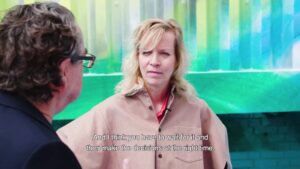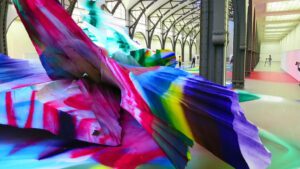
It Wasn't Us
by Christian Hain

Quite unexpectedly, a visitor’s first thought upon entering Katharina Grosse’s single–work show at Hamburger Bahnhof Museum might be: ‘Underwhelming’. That’s remarkable, because the German artist is known – and very well known, being represented by some of the best multinational powerhouse galleries – for ‘in your face’ artworks that are as powerful as they are colourful. You’d expect to feel dumbfounded on the spot, and only later brush away some minor doubts about the genuine greatness of what you’ve seen. This time it’s the other way round, with initial coldness turning to enthusiasm, and this is not, or not exclusively, the artist’s doing, but because of the architecture of Hamburger Bahnhof. The erstwhile train station’s main hall is a huge exhibition space with a magnificent roof construction of black iron, corresponding pillars and windows, that make it a character of its own. Deciding what to show here can never be easy, as long as you don’t want to go full d’Orsay and make it a regular space with moveable walls.
To be fair, Katharina Grosse’s art fits the surroundings much better than Cevdet Eret’s installation (great in itself, but tremendously undersized) that was shown here before, in autumn 2019. Yet on first sight, the architecture still dominates and smothers the art without any discernible link between the two. We already perceive some – even many – colours from afar, from a first, imprecise, idea of things to come, but it feels like regarding a painting with too much ‘social distance’, and that’s a pity. However, as soon as you approach, initial doubts vanish, and the fun begins.
The show forms one work but can be divided in three parts: floor, sculpture, and outside. All have been painted, or more precisely sprayed upon, with a paint gun, and find themselves covered in kaleidoscopic curls, circles, and curves like a painter’s palette or studio floor swept away into the outer world. The colours scream ‘graffiti’, but also ‘kindergarten’ – childlike, not childish – evoking traces of chalk on the street. A massive thunderstorm hit Berlin the day before the opening (not really an ‘opening’, only the first day of public access with obligatory online reservation; there was no preview or press reception). The curious visitor bows down, touches the surface ever so softly, then raises a finger to the eye, but no it’s not chalk, these colours are firmly attached – even outside, where the rain fell. Nevertheless, with every squeaking of our shoes we check again, whether we’ve caught a piece of art under the soles (even if you did, framing and auctioning wouldn’t be a great idea).
As we worry already about de-installation, a hoarse voice makes us tremble: “Please, don’t touch!”, but it’s not meant for us still crouching on the floor, somebody else got too close to the sculpture. This is annoying because this art wants to be touched as naturally as it is walked upon, and yet that central part is extremely fragile. “Styrofoam”, someone mutters, and stepping closer, we’re briefly misled into correcting him, “splintered wood, even metal?”, then agree: Styrofoam. Styrofoam formed to a three-dimensional abstract painting, continuing the floor as visitors do themselves by walking around, adding the colour of their clothes and skin to the ‘painting’ like moving flowers or stalagmites. The more we approach, the better it gets, offering new sights from every angle – is this the inside of an ice cave or crevasse, with the sun summoning iridescent images on walls brimming with crystals and esoteric gemstones, the world seen through a prism, or whatever means you prefer to enhance your vision? A descent into the multi-coloured maelstrom?
The installation invites these comparisons and a free play of associations. Do you see half a pipe, splintered spears and hand axes, butterflies in strobe light? Is the highest summit in the back reminiscent of the Rolls Royce spirit of ecstasy, or a fighter jet, or paper plane? On second, third, umpteenth look, ever new connotations arise, a bird – an eagle perhaps, flying fish, a dolphin emerging from uneasy waters. Suddenly, you catch more maritime vibes, imagine a waterslide, icebergs, high towering waves… All this is ‘true’ and ‘wrong’ at the same time. Katharina Grosse’s painting-installation tests, and stimulates, the onlooker’s proper creativity on an open field of interpretation like a Rorschach test for everyone.
At some point, we discover Styrofoam steps leading nowhere or to imaginary temples – aren’t these colours evocative of Tibetan (RIP) sand mandalas, too? Which reminds us: caution, steps. Not those in the middle of the sculpture that you mustn’t touch for their own safety, but others on the floor of Hamburger, perfectly camouflaged by the paint. Contrary to custom, there are no warning signs, and if you only have eyes for the art, they’ll take you back to reality with a bang.

Outside, the colour explosion continues, art spreading like an infection into the neighbourhood, a virus, or happiness and laughter that can be quite infectious too; only the trees have been exempted, unlike in earlier Grosse-installations. The world itself serves the artist for a canvas, no museum doors could contain this tsunami fed from Brobdingnagian colour barrels. Better don’t try the reverse, getting in for free, as some did: the wardens are watching.
For a moment, we’re lost: is this not where the Rickhallen (“Rieck Halls”) are supposed to be, an annexe to the museum that will soon be demolished because Hamburger Station has only had it on loan, like the collection shown in there? Has the demolition already taken place? But no, it’s just that we’ve never been here before, in the backyard behind usually closed doors. There’s also a large metal framework, a trellis without plants – might be art or not, and even a cafeteria by the canal.
I should mention that we found colourless bits of Styrofoam in the gutter – not exactly environmentally friendly. As for the Rieckhallen, they’re still standing, right there on our left, the outer wall painted up to a point some 50 metres away. They now resemble a playground for kids, with graffiti walls to write and tag on legally (doesn’t that take all the fun out of it?). Here too, everything is legal, and in perfect order – it’s Germany after all. Although the artwork reaches a long way, in fact the whole wall has not been painted – every ‘no parking’ sign has been carefully excluded, and there are a lot of them. They’re probably needed to keep the new neighbours at bay, some (potentially expensive, for Berlin standards) condos seem already inhabited, while more are under construction.
There could be some protest involved in this show: how better to manifest your claims to these halls that you would love to keep, possibly on a ‘permanent loan’, i.e. forever, just like the collection they host and which its owner, Mr Flick, has already threatened to take away to Switzerland, than by putting them in focus with a huge installation? Smart move.
Overhearing a group bent over a point where the multi-coloured floods have come to a halt, and stepping to their side, we notice it too: a transparent film covers the wall up to here, and Grosse has only worked on this – there is still hope, the wall won’t come down anytime soon!
If you dropped your face-mask in open-air enclosure, don’t forget to put it back on when returning inside (as we did more than once). There, reading the exhibition title again, It Wasn’t Us, we wonder, and not only about the grammar: who is ‘us’? The artist and her assistants (royal we)? Higher beings command … or what was the name of that canonical Polke work again? Having imagined a maritime context before, we now think of ‘petrol’, and not little streams of rainbow running down the street in heavy rain, but an oil tanker’s wreckage in Arctic waters, glistening death on a sunlit surface – we definitely did that, ‘we’ as in humanity.
Katharina Grosse’s art puts a smile on your face, and you hope this is true for everyone, even though you cannot see the other patrons’ faces for their masks. Hers is a colourful world, and somehow clownish, in a positive way. Talking influences, we’ve mentioned street art more than once, also think Pollock, next level, and Grosse won’t drip: she pours. As with Abstract Expressionism’s founding father, there’s little chaos and coincidence involved, and much elaborate planning. She probably couldn’t avoid thinking big: ‘Grosse’ means ‘(the) great’, as in ‘Catherine/Katharina, the’, although she chooses to pronounce it differently – her parents obviously didn’t want her to suffer any inferiority complexes. Now imagine she’d chosen – or been allowed to choose – to use the entire station hall instead of merely a third, not stopping short at walls and even the ceiling!
Katharina Grosse: It Wasn’t Us, Hamburger Bahnhof, 14 June 2020-10 January 2021
Volume 35 no. 1 September / October 2020

